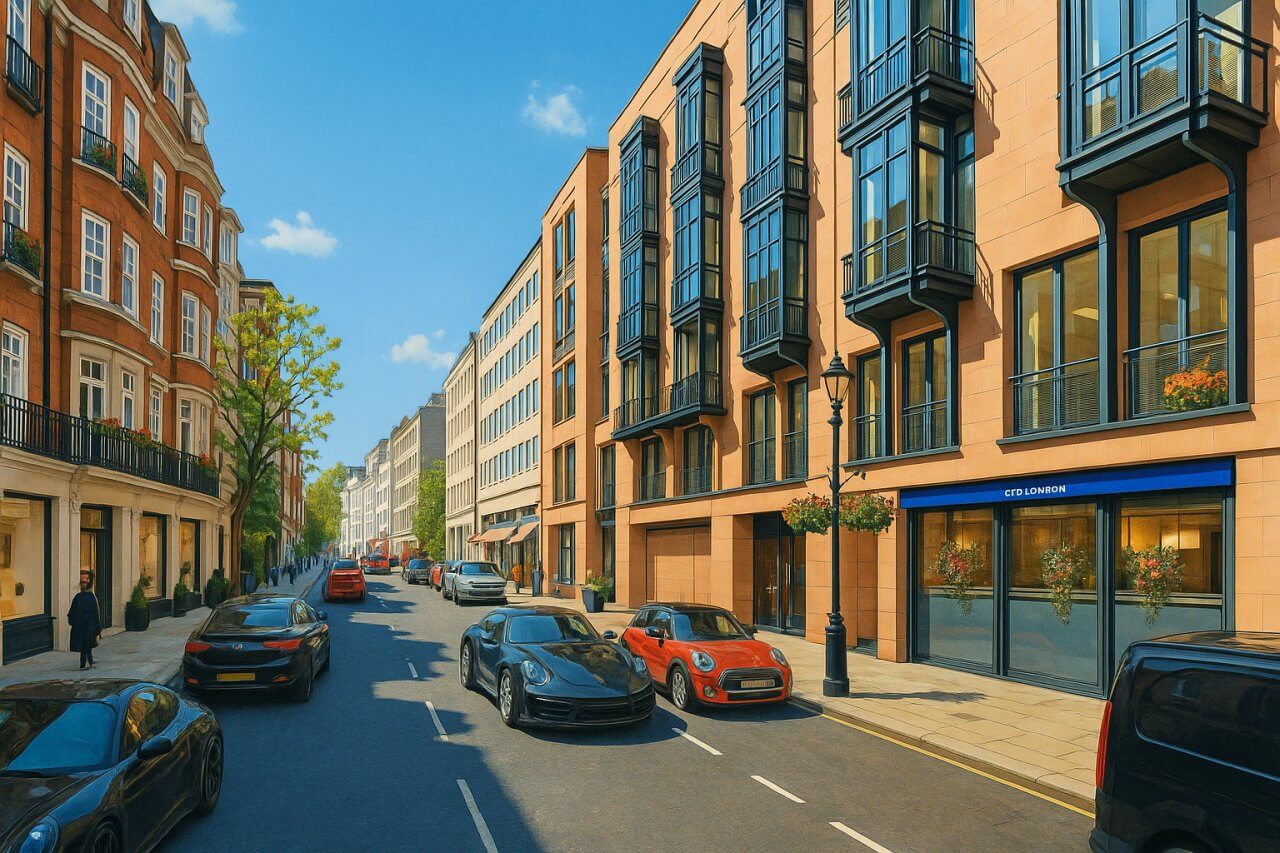
Davies Street, London
Davies Street is a distinguished thoroughfare in Mayfair, part of the City of Westminster in central London. Running from the bustling Oxford Street in the north to the elegant Berkeley Square in the south, the street is a key axis through Mayfair’s upscale commercial and residential landscape. With a combination of Georgian architecture, fine art galleries, luxury boutiques, and stately buildings, Davies Street epitomises the grandeur for which Mayfair is known.
Location and Surrounding Streets
Davies Street forms a vital spine through the heart of Mayfair, bordered by significant streets such as Brook Street to the east, Grosvenor Street to the south, and South Molton Lane to the west. The northern junction opens onto the busy shopping district of Oxford Street, while its southern end reaches the tree-lined Berkeley Square.
The surrounding area features notable cross-streets and passageways including Weighhouse Street, South Molton Street, and Hill Street. These all contribute to the highly walkable and elegant nature of this part of Westminster.
Historical Background
The development of Davies Street dates back to the early 18th century during the expansion of the Grosvenor Estate, the primary landowner in Mayfair. The street was laid out as part of a grid pattern to accommodate London's westward expansion of aristocratic residences and high society establishments.
Davies Street is named after the Davies family, who were related to Sir Thomas Grosvenor by marriage. Mary Davies, the heiress whose dowry included 500 acres of land west of what was then London, brought the land into the Grosvenor family, forming the basis of what became the prestigious Grosvenor Estate.
Streets connecting to Davies Street
- Bourdon Street
- Brook Street
- Brook's Mews
- Davies Mews
- Grosvenor Street
- Mount Row
- Mount Street
- Oxford Street
- St Anselm's Place
- Three Kings' Yard
- Weighhouse Street
Architecture and Streetscape
Much of the street retains its Georgian character, with elegant red brick façades and large sash windows. Some buildings have been redeveloped or repurposed, especially near Bond Street, to accommodate modern office and retail usage, though planning controls have maintained the historical charm of the street. Art deco and Edwardian touches are also visible, reflecting waves of redevelopment through the 19th and 20th centuries.
Points of Interest and Attractions
- Grosvenor Chapel: A charming 18th-century chapel located just off Davies Street on South Audley Street, used for traditional Anglican services and events.
- Gagosian Gallery: An internationally renowned contemporary art gallery located at 20 Grosvenor Hill, easily accessible from Davies Street.
- Claridge’s Hotel: Although not directly on the street, this iconic luxury hotel sits around the corner and adds to the area's prestige.
Numerous private members' clubs, such as The Arts Club and George, are also located within walking distance, contributing to the street’s affluent social life.
Real Estate and Property Market
As of mid-2025, property on Davies Street ranks among the most expensive in London. Commercial office space and residential flats frequently exceed £3,000 per square foot (£32,300 per sq metre). A two-bedroom flat of around 1,500 sq ft (140 sq m) may sell for £4.5 million or more, depending on floor level and building quality. Rental prices are equally steep, reflecting the street’s proximity to major amenities and prestige retailers.
Transport and Accessibility
London Underground
Davies Street is excellently served by the London Underground, with the closest station being Bond Street Station, located directly at the northern end of the street. Bond Street is served by the Central Line and Jubilee Line, providing swift connections across central and suburban London.
Other nearby stations include:
- Oxford Circus Station – serving the Bakerloo Line, Central Line, and Victoria Line.
- Green Park Station – providing access to the Jubilee, Piccadilly, and Victoria Lines.
- Bond Street Station – providing access to the Central, Jubilee and Elizabeth Lines.
The area is well supported by various London Underground Stations, making it convenient for both commuters and visitors.
Bus Services
Nearby bus stops along Oxford Street and Brook Street offer routes connecting Davies Street to key destinations across the city. Major bus routes include 7, 10, 55, 73, 98, and 390, among others. Night buses also service the area, ensuring round-the-clock connectivity.
Fun Fact
Davies Street is home to one of Mayfair’s quirkiest features: an old Metropolitan Police call box that has been retained near Grosvenor Square. Though no longer in official use, it’s a rare survivor from the days before mobile communication and serves as a subtle reminder of London’s layered history.
Quick Facts
- Location: Mayfair, City of Westminster, London
- Runs from: Oxford Street (north) to Berkeley Square (south)
- Nearby Streets: Brook Street, South Molton Lane, Grosvenor Street, Hill Street
- Historical Origin: Early 18th century, developed by the Grosvenor Estate
- Named After: Mary Davies, heiress whose land formed the Grosvenor Estate
- Key Sights: Grosvenor Chapel, Gagosian Gallery, Claridge’s (nearby)
- Nearest Tube Station: Bond Street Station (Central Line, Jubilee Line)
- Other Nearby Stations: Oxford Circus, Green Park
- Bus Routes: 7, 10, 55, 73, 98, 390, and night services
- Property Prices (2025): Approx. £3,000/sq ft (£32,300/sq m)
- Notable Feature: Historic Metropolitan Police call box near Grosvenor Square
References
- Grosvenor Estate – Our History
- Evening Standard: Mayfair Property Market Update
- Historic England: Grosvenor Chapel Listing
Map of Davies Street, London
 Painting of Davies Street, London
Painting of Davies Street, London